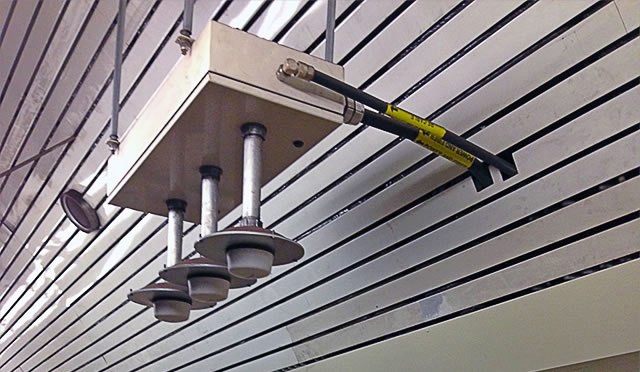
Cellular DAS

Distributed Antenna Systems is a network of spatially separated antennas that receive their waves from one or more central antennas, providing a wireless network within a geographic area or structure.
With a standard in-building Distributed Antenna System the cellular source is usually at a higher elevation, and it provides the wireless signal to the building. Signals are transmitted into the building through head-end equipment which converts the RF signals to digital pulse signals. Wireless distribution then disperses the digital signals throughout the building by way of fiber cabling, and are received by remote node locations that convert them back into RF signals and radiate them through multiple, strategically situated antennas for reliable in building wireless coverage.
For larger applications or for stadiums, cellular coverage is usually not an issue. The problem is when you have 80,000 fans at a football game the capacity of the macro environment cannot adequately service so many simultaneous connections. Distributed Antenna Systems for stadiums are therefor fed through a carrier installed network of base stations. This enables the integrator to sectorize the DAS into many smaller area, enabling many small cells which enhances the capacity and coverage.
At RF Freqs we are technology neutral and will work on the solution that makes the most sense for our Clients. There have been many scenarios where RF Freqs have recommended alternate solutions over DAS such as cell repeater solutions, it all depends on our customers unique needs, the specific market and the requirements of the Wireless Carriers network specifications”.
RF Freqs interfaces with the Wireless Cellular Carriers to obtain design approvals and Rebroadcast agreements so building owners are FCC compliant and that the DAS system design and equipment meets the specification of each Carrier in market. No matter the size or type of structure, RF Freqs can design a DAS system for any complex.
In-building cellular is now one of the leading verticals in the technology sector. Reliable wireless distribution is an integral part of business and pleasure, and it is only high quality wireless communication systems that can deliver an optimal wireless network system. So it’s important to find a company that has the knowledge, expertise, and professionalism to handle your In building wireless installation, such as RF Freqs
Our Cellular DAS System Services Include:
In this milestone we will produce design schematics based on Ibwave design criteria. The design and a list of all equipment required-BOM will be provided to the Carriers for their review and acceptance. System designs will be modified based on Carrier equipment and coverage criteria for the region the property is located. The formal request for review and approval will be presented to each Carrier in accordance with their approval process.
On our Client’s behalf we will coordinate with WSPs in obtaining rebroadcasting agreements with the Carriers to ensure FCC compliance for accessing the WSP networks. Upon execution of the rebroadcast agreements equipment provisioning and installation construction will commence.
The DAS equipment will be selected according to the coverage requirements, RF link budget specifications and customer aesthetic needs. The equipment will include coaxial or fiber cable, repeaters, remotes, signal conditioners, transmitters, distribution antennas, consumables and other necessary equipment.
We will review with the Client the costs and the funding options for the system and review the system coverage objectives and refining any redesign criteria in the event the Carriers require additional equipment or system modifications. In the event of the costs associated with the DAS system varies from the initial quoted amount, review and approval from Client will be required. Equipment commissioning and configuration changes will be revised and services will be contracted and a final work order will be finalized between RF Freqs and Client.
Commencement of construction implementation will begin based on a pre-approved schedule provided to the Client’s representative for approval to proceed. All work during this phase will be summarized and reported to the Client on a regular basis. Inspections of worked performed can occur from time to time with the Project Manager or the on the job supervisor. The distributed antenna system ‘DAS’ will be commissioned which requires Carrier coordination and inspections. Each of the Carriers will send their engineers to work with our staff to ensure system compatibility with their networks. The carriers typically install additional equipment at this time.
Once installation is completed, we will conduct the following testing:
- Sweep testing: All lines will be swept to ensure proper installation and band compatibility of all components.
- Ibwave mapping, documenting wireless coverage per floor.
- Additional testing available and charged as a “Change Order”.
Typically the major DAS manufacturers provide a 1 year warranty on all their component equipment and RF Freqs will offer a one year conditional warranty on its’ installation services as long as all warranties are in effect. Maintenance are designed to address the specific needs of our Clients. Cost of materials and equipment will be not be included, unless they are warranty products, and at an additional charge. Above all else, our guiding principle is to provide cost-effective, complete and exceptional service with full support for our valued clients.
